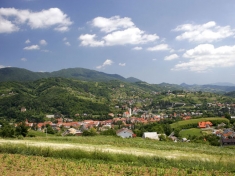Krapina
Krapina – the centre of Krapina-Zagorje County
Krapina is today the cultural, political and administrative centre of Krapina-Zagorje County, covering 1264 km2. It is home to 150,000 inhabitants, which means that it is the largest region in Hrvatsko zagorje. The county’s connection to Europe will be much better once traffic conditions are normalised and the E-59 highway, part of the European road traffic system (Pyhrana Route) is completed. Today approximately 13,000 people live in the town of Krapina. The main industrial branches are textiles and garments, production of housing containers and potassium stoves, Styrofoam, wiring supplies from plastic material, and construction industry specialized in the restoration of classical buildings with a large share of a craftsman works. A new business and trade centre will also be opening soon in Krapina; the town offers not only trade but also intellectual services, including marketing and project management firms, legal and financial services, medical and dental services, as well as many personal services such as hairdressing, pedicures, beauty salons, photography, photocopying shops, laundry services etc.The fact that Krapina is the political centre of the county has historical roots. Krapina County (comitatus crappinensis) was mentioned as early as 1222 in the 1222 charter of Duke Béla where prince Petar of Krapina was named the head of the Croatian noble parish (Petar “comes de Crapuna”). King Sigismund of Croatia and Hungary, who owned an estate in Krapina (Castrum Carpone), awarded the mayor of the town of Krapina the title of the Great Count of Zagorje County in 1399. During the administration of ban Ivan Drašković, five sessions of the Croatian Parliament were held in Krapina at the turn of the 17th century. Ante Starčević, the Father of the Nation, and bishop Juraj Strossmayer, signed political agreements in Krapina that defended Croatia’s interests.
Today, Krapina-Zagorje County is a territorial administration and self-governing unit that unites all the towns of the Croatian Zagorje region, without limiting the autonomy of any of them. It emphasises the unity of the region rather than its constituent parts and creates a whole that has “Zagorje in its heart” (a local saying).
The best time to visit the Croatian region of Zagorje is the autumn when the days are clear, the skies are blue, and the treetops turn gold. There is no better time to look at the Zagorje hills from which you will be able to see undulating green, brown, yellow and blue colours, white roads which joyfully meander among the villages and into the forests or other hidden corners which escape the eye. You will see houses scattered around the hills and cattle on the pastures. The wind will carry the scent of grapes from vineyards and the scent of apples from the orchards. In autumn, the forests soon bear ripe chestnuts.
While looking at Zagorje from one of its many hilltops, even if only for a moment, you will feel like the Creator himself when He was creating the world and “all the evils, troubles and doubts suddenly become small...” in the words of the famous Croatian poet, Dobriša Cesarić. Is this the reason why the chapels of Zagorje are built on the highest hilltops?














